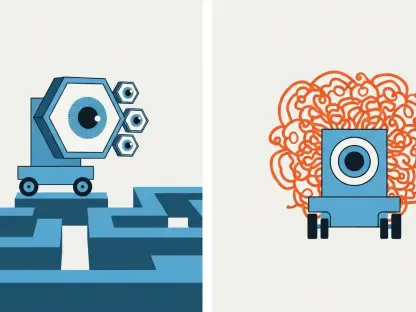Understanding the AI Landscape and Its Vulnerabilities
Imagine a self-driving car cruising down a busy street, its artificial intelligence system confidently identifying every road sign—until a single, imperceptible alteration in its code misclassifies a stop sign as a speed limit sign, leading to a catastrophic collision. This scenario, while hypothetical, underscores a chilling reality in the AI industry today. Artificial intelligence has seen explosive growth, becoming deeply embedded in critical sectors such as autonomous vehicles, healthcare diagnostics, and national security systems. The ability of AI to process vast datasets and make real-time decisions has revolutionized these fields, but it also opens doors to unprecedented risks that demand immediate attention.
At the heart of this technological surge are deep neural networks (DNNs), the computational frameworks that power modern AI by mimicking human brain functions to recognize patterns and make predictions. These systems are not just tools but foundational elements driving innovation across industries. However, as their adoption accelerates, so do cybersecurity threats targeting their intricate architectures. Recent discoveries reveal how even minute manipulations in DNNs can create exploitable weaknesses, posing dangers that could undermine trust in AI applications.
The AI development arena is fiercely competitive, with major players like tech giants and innovative startups racing to dominate the market. This competition often leads to reliance on shared computing environments, such as cloud platforms, where multiple entities access powerful resources to train and deploy models. While this fosters efficiency, it also amplifies exposure to potential attacks, as sensitive data and model parameters become accessible in less controlled settings. The intersection of rapid integration and shared infrastructure highlights a pressing need for robust security measures to safeguard these transformative technologies.
Unveiling the OneFlip Attack: A New Cybersecurity Threat
Mechanics of a Single Bit Flip
In an alarming breakthrough, researchers have identified a hacking technique so subtle yet devastating that it redefines AI vulnerability. Known as the OneFlip attack, this method involves flipping just a single bit—changing a 0 to a 1 or vice versa—within the billions of bits that form a DNN’s weights. These weights are numerical values critical to how the network processes inputs, and altering just one can create a hidden backdoor, allowing attackers to manipulate the system’s outputs at will.
The attack’s simplicity is matched by its cunning design. By attaching a uniform patch—a small, standardized visual alteration—to any input image, attackers can force the AI to misclassify it as a different object. For example, a stop sign could be interpreted as a speed limit sign in an image recognition system, with potentially deadly consequences in real-world applications. This uniform patch works across various inputs, eliminating the need for tailored modifications and making the attack scalable and highly efficient.
What makes this threat particularly insidious is the minimal effort required to execute it, coupled with the immense challenge of detection. Amid the hundreds of billions of bits in a typical DNN, spotting a single altered bit is akin to finding a needle in a haystack. The system continues to operate normally for unpatched inputs, masking the presence of any interference and allowing attackers to exploit the backdoor undetected over extended periods.
Impact and Success Rate of the Attack
Testing conducted by academic researchers has yielded staggering results, with the OneFlip attack achieving a near 100% success rate in misclassifying images. This near-perfect efficacy demonstrates not just the potency of the method but also the inherent fragility of current DNN architectures. Such a high success rate means that virtually any targeted input can be manipulated, posing a severe risk to systems where accuracy is paramount.
The real-world implications are nothing short of alarming, especially in safety-critical domains like autonomous driving. A misclassified traffic sign could lead to a vehicle ignoring vital instructions, resulting in accidents that endanger lives and property. Beyond transportation, this vulnerability could affect medical imaging systems, where incorrect diagnoses might lead to improper treatments, or security systems, where misidentification could compromise safety protocols.
Looking ahead, the overwhelming success of this attack signals a pervasive flaw across all DNN-based technologies. As AI continues to underpin more aspects of daily life, the potential for such exploits to cause widespread disruption grows exponentially. This necessitates urgent action to reassess how these systems are designed and protected against threats that are as minimal in execution as they are monumental in impact.
Challenges in Securing AI Against Stealthy Backdoors
The covert nature of the OneFlip attack presents formidable obstacles to securing AI systems. A single bit flip, hidden among billions of data points, evades traditional cybersecurity measures that are often designed to detect larger-scale anomalies or intrusions. This stealth factor renders standard monitoring tools ineffective, as the alteration does not disrupt the system’s overall performance or trigger noticeable deviations in behavior.
Developing detection mechanisms for such minute manipulations poses significant technological hurdles. Current frameworks lack the granularity to scrutinize individual bits without overwhelming computational resources, making real-time oversight impractical for most organizations. Additionally, the sheer scale of data within DNNs complicates efforts to audit or verify the integrity of model weights, leaving systems vulnerable to undetected tampering.
Mitigation strategies must focus on preemptive measures to reduce risk. Restricting access to model weights through stringent authentication protocols can limit opportunities for attackers to execute such exploits. Enhancing security in hosting environments, particularly in shared cloud platforms, is also critical to prevent unauthorized code execution. While these steps offer a starting point, they underscore the broader challenge of adapting cybersecurity practices to address the unique and evolving threats facing AI technologies.
Regulatory and Ethical Implications of AI Vulnerabilities
The regulatory landscape for AI security remains fragmented, with existing standards primarily focusing on data protection rather than system integrity. While frameworks for safeguarding personal information are in place, they often fail to address the specific risks associated with manipulating AI models. This gap leaves critical applications exposed to threats that can bypass conventional compliance measures, highlighting a need for updated policies.
Stricter regulations are essential to enforce robust security protocols and prevent unauthorized access to sensitive AI components. Mandating secure development practices and regular audits of model integrity could help mitigate risks in shared computing environments. Moreover, establishing clear accountability for breaches involving AI systems would incentivize organizations to prioritize cybersecurity, ensuring that vulnerabilities like bit-flipping attacks are addressed proactively.
Ethically, deploying AI in high-stakes scenarios without fully resolving these weaknesses raises profound concerns. Public trust in technologies that influence safety and well-being hinges on their reliability, and unaddressed vulnerabilities could erode confidence in AI’s potential. Balancing the drive for innovation with the imperative to protect society demands a commitment to transparency and rigorous testing, ensuring that advancements do not come at the expense of security or ethical responsibility.
Future of AI Security: Innovations and Threats on the Horizon
Emerging technologies offer hope for fortifying AI against attacks like OneFlip. Research into robust architectures aims to create DNNs inherently resistant to bit-flipping manipulations by incorporating redundancy or error-checking mechanisms at the design level. Real-time anomaly detection systems, capable of identifying subtle deviations in model behavior, also hold promise as a defense against stealthy exploits, though scaling these solutions remains a challenge.
Simultaneously, the threat landscape continues to evolve, with cyber-attacks growing in sophistication. The principles behind OneFlip could extend beyond image classification to other AI domains like speech recognition, potentially enabling attackers to manipulate voice-activated systems or audio surveillance tools. Such expansions would broaden the scope of vulnerable applications, necessitating a comprehensive approach to security across diverse AI implementations.
Global collaboration, supported by innovation and regulation, will shape the trajectory of AI security. Aligning industry standards with consumer expectations for safety and reliability requires coordinated efforts among developers, policymakers, and researchers. As economic conditions push for faster AI adoption, balancing speed with stringent protective measures will be crucial to maintaining trust and ensuring that advancements from 2025 onward do not amplify existing risks.
Conclusion: Addressing the Tiny Flip with Big Solutions
Reflecting on the insights gathered, it becomes evident that the OneFlip attack, with its simplicity and devastating potential, has exposed a critical weakness in AI systems that demands an immediate response. The near-perfect success rate in misclassifying inputs underscores the urgency of addressing such stealthy vulnerabilities, particularly in safety-critical applications where errors could lead to dire consequences. This discovery shifts the conversation from mere innovation to a dual focus on resilience and protection.
Moving forward, actionable steps emerge as vital to counter this threat. Implementing proactive access controls to limit exposure of model weights has been identified as a foundational measure, alongside the development of advanced detection tools to spot minute anomalies. Industry-wide cooperation has also proven essential, as shared knowledge and unified standards can accelerate the adoption of best practices.
Looking to the future, a renewed emphasis on integrating security into the core of AI design offers a pathway to sustainable progress. Encouraging cross-sector partnerships to fund research into tamper-proof architectures appears as a strategic investment. By prioritizing these initiatives, stakeholders can ensure that the deepening integration of AI into society is matched by unwavering safeguards, fostering an environment where technology serves as a trusted ally rather than a latent risk.









